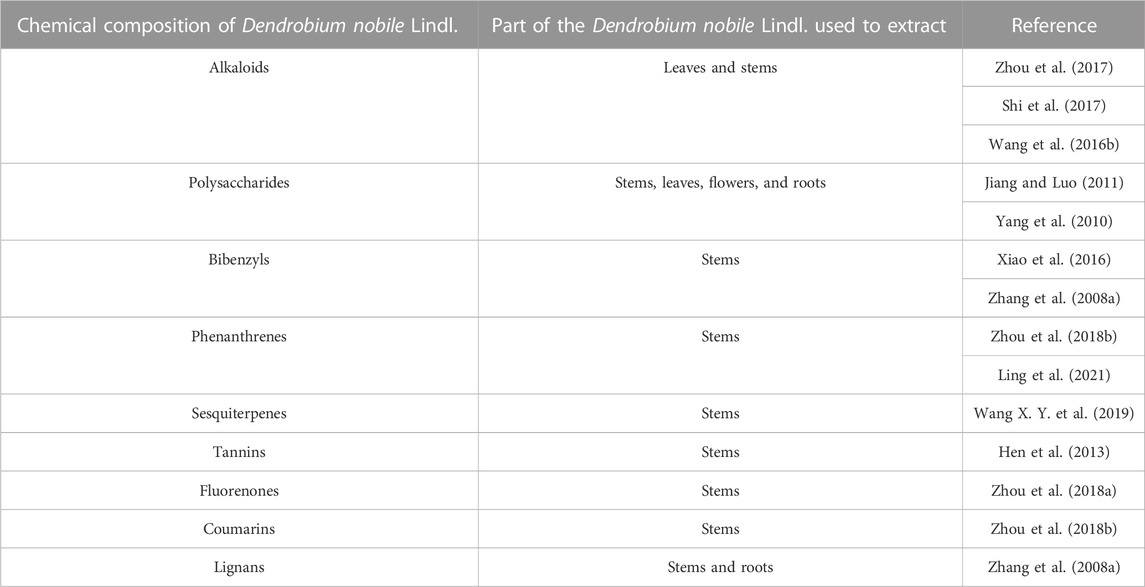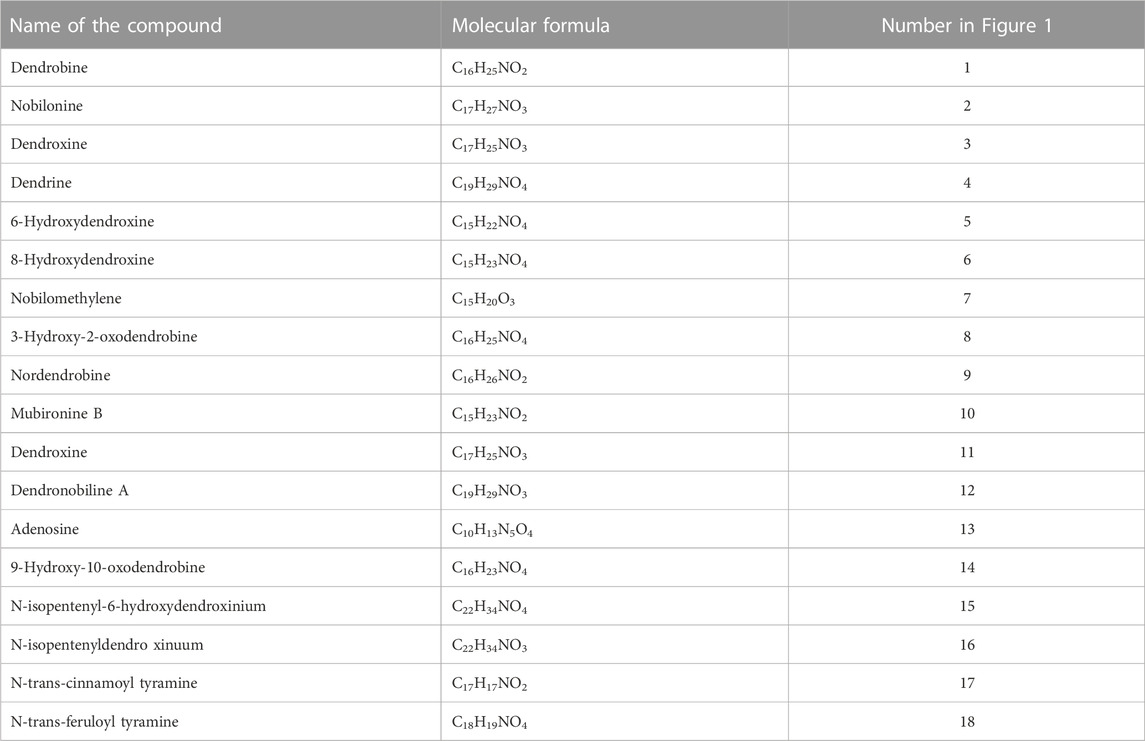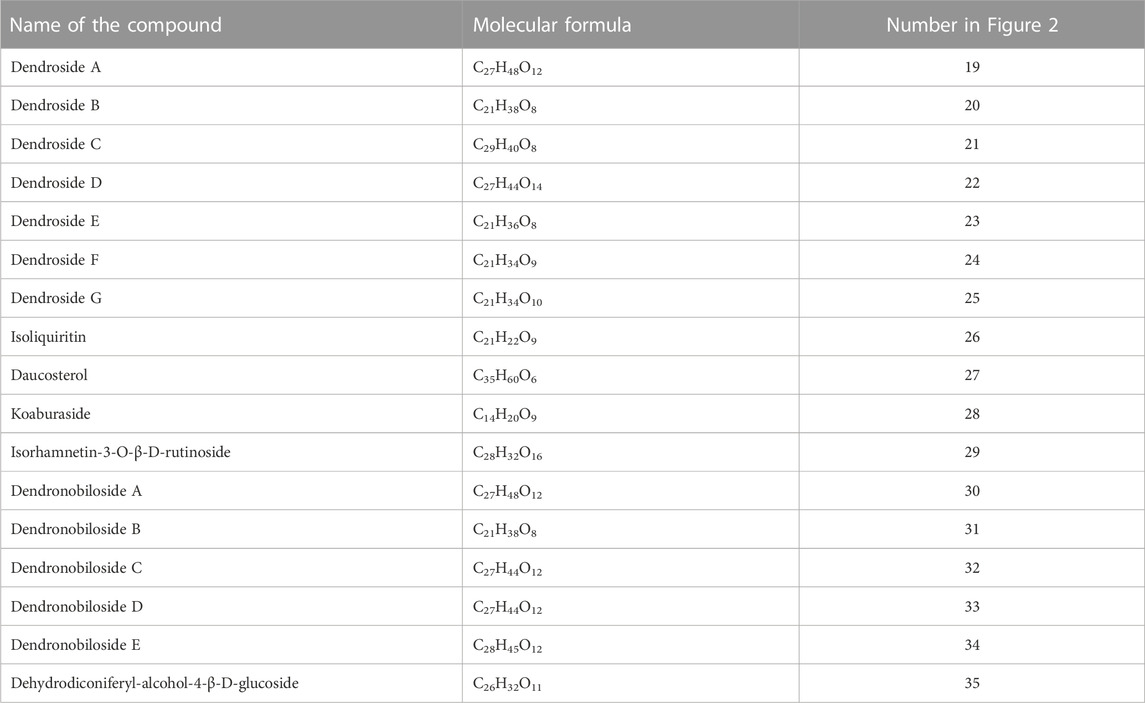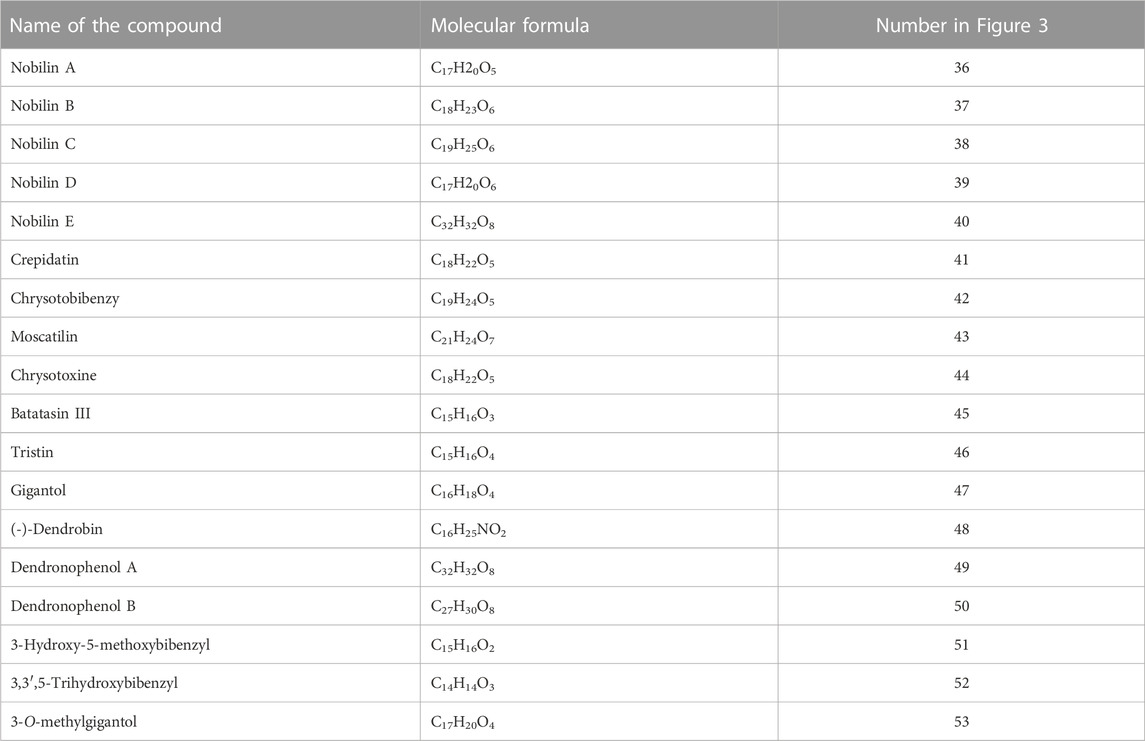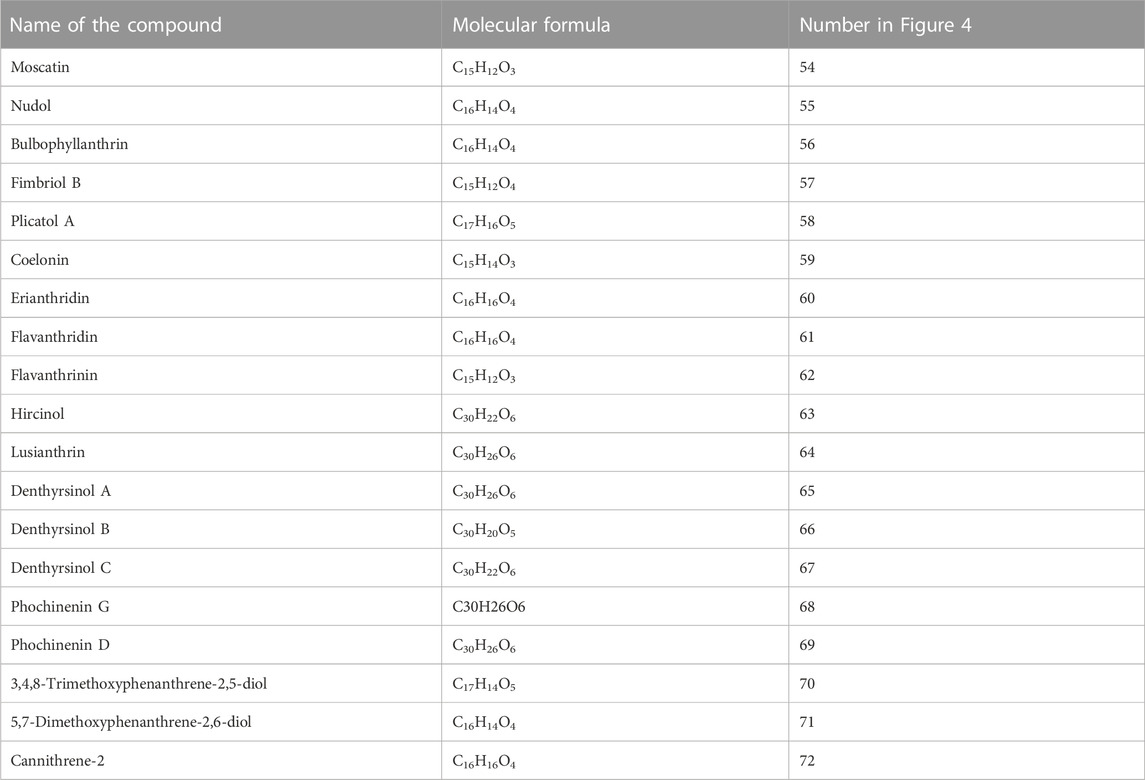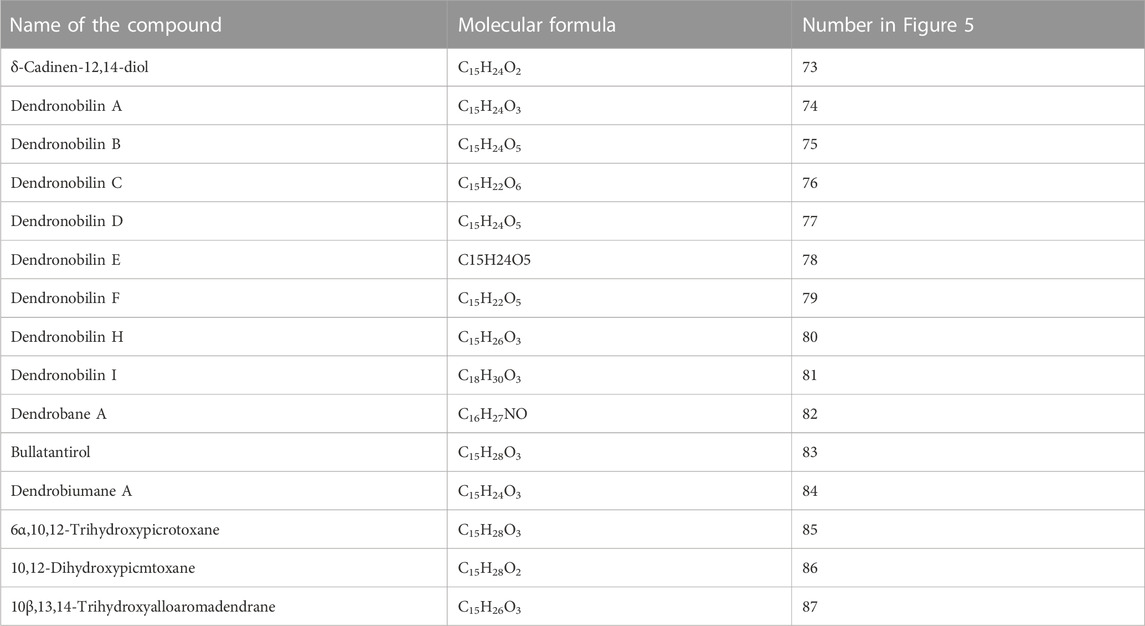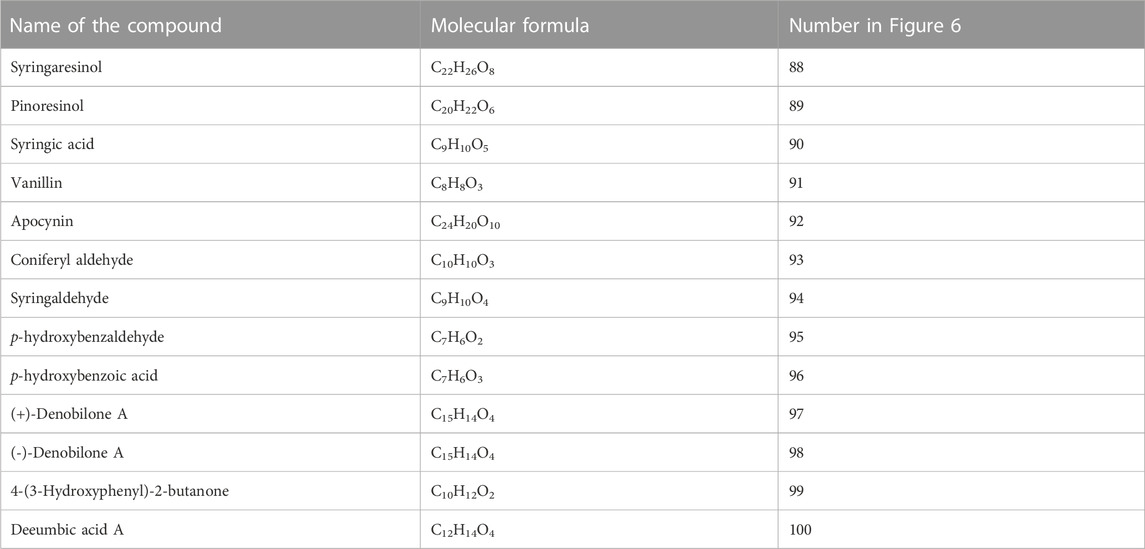- 1Department of Immunology, Special Key Laboratory of Ocular Diseases of Guizhou Province, Zunyi Medical University, Zunyi, Guizhou, China
- 2Special Key Laboratory of Gene Detection and Therapy of Guizhou Province, School of Basic Medical Sciences, Zunyi Medical University, Zunyi, Guizhou, China
Dendrobium nobile Lindl. belongs to the genus Dendrobium of the orchid family and is a valuable herbal medicinal material. The information in this paper has been collected from the scientific literature databases including PubMed, Google Scholar, Web of Science, SciFinder, China National Knowledge Infrastructure, published books, Ph.D., and M.S. dissertations systematically in recent 20 years. “Dendrobium nobile Lindl.,” “chemical composition,” “pharmacological activities,” and “diseases” were used as search terms to screen the literature. The collected chemical compositions are classified and summarized according to their different chemical structures, and the clinical disease treatment effects of Dendrobium nobile Lindl. are classified and summarized based on their pharmacological activities and different experimental disease models. Recent studies have revealed that Dendrobium nobile Lindl. contains chemical components such as alkaloids, bibenzyls, sesquiterpenes, phenanthrenes, and polysaccharides, and that its pharmacological activities are closely related to the chemical components, with pharmacological activities such as anti-tumor, anti-aging, immune enhancement, hypoglycemic, and anti-cataract. Currently, researchers are conducting extensive and detailed studies on Dendrobium nobile Lindl. and research experiments on its chemical constituents in the treatment of various clinical diseases. Therefore, the purpose of this paper is to review the chemical composition of Dendrobium nobile Lindl. and its experimental studies in the treatment of diseases and to provide a scientific reference for the future application of Dendrobium nobile Lindl. in the treatment of diseases.
1 Introduction
Dendrobium nobile Lindl. is a valuable Chinese medicinal material belonging to the genus Dendrobium of the orchid family (Lam et al., 2015). It is the earliest identified species of Dendrobium in ancient Chinese medicinal herbs and one of the main varieties of medicinal dendrobiums in China. It has a long history of application and is one of the most valuable medicinal plants in Guizhou province, China. Due to its excellent medicinal properties, Dendrobium nobile Lindl. was listed as the original species of medicinal dendrobium in the 2010 edition of the Chinese Pharmacopoeia, attracting the attention of many researchers. The related literature shows that Dendrobium nobile Lindl. is a medicinal plant containing mainly alkaloids, bibenzyls, sesquiterpenes, phenanthrenes, polysaccharides, and other chemical compositions. Its pharmacological effects appear mainly as anti-tumor, anti-aging, immune enhancing, hypoglycemic, and anti-cataract (Huang et al., 2017; Chao et al., 2018). Recently, the active constituents of Dendrobium nobile Lindl., especially alkaloids and polysaccharides, have been found to have significant therapeutic effects against tumors, hypoglycemia, and nervous system diseases, and some proprietary herbal medicines based on Dendrobium nobile Lindl. has been used in the treatment of a number of diseases. With the continuous development of modern molecular chemistry and pharmacology, various chemical constituents have been isolated from Dendrobium nobile Lindl., and their multiple pharmacological actions have been revealed. In addition, chemical constituents have been studied for the treatment of various diseases. Therefore, the purpose of this paper is to summarize the experimental studies on the chemical constituents of Dendrobium nobile Lindl. and to provide a scientific reference for future applications of Dendrobium nobile Lindl. in the treatment of diseases.
2 Chemical composition of Dendrobium nobile Lindl.
In recent years, the chemical constituents of Dendrobium nobile Lindl. have been systematically studied, revealing that it contains a wide variety of chemical constituents. Based on its structure, the main chemical constituents of Dendrobium nobile Lindl. can be divided into alkaloids, polysaccharides, phenanthrenes, sesquiterpenes, and bibenzyls (Table 1), among which alkaloids are the characteristic composition of Dendrobium nobile Lindl.
2.1 Alkaloids
Alkaloids are natural organic compounds containing nitrogen heterocycles found in plants, and these nitrogen atoms determine the alkalinity of alkaloid compounds (Heinrich et al., 2021). Alkaloids are the characteristic constituents of Dendrobium nobile Lindl. and are the main active substances. The alkaloids were first isolated and purified from the stems and leaves of Dendrobium nobile Lindl. in 1932, and it was found that alkaloids were mainly distributed in the stems of Dendrobium nobile Lindl., which led researchers to generally adopt the stem part of Dendrobium nobile Lindl. for the extraction and isolation of alkaloids in the subsequent process (Zhou et al., 2017; Shi et al., 2017; Wang et al., 2016b). The alkaloids of Dendrobium nobile Lindl. have anti-tumor, hypertension-reducing, and nervous system-protecting effects (Mou et al., 2021). In recent years, several research studies have been conducted on the alkaloids of Dendrobium nobile Lindl., and various types of alkaloids are constantly being discovered. To date, the structural and molecular formula of various alkaloids have been identified, including dendrobine, nobilonine, dendroxine, dendrine, 6-hydroxydendroxine, and 8-hydroxydendroxine (Chen and Shi, 2016). The alkaloids isolated from Dendrobium nobile Lindl. are listed in Table 2, and their chemical structures are shown in Figure 1. The reason why alkaloids are the unique component in Dendrobium nobile Lindl. is thought to be due to their higher content compared to other Dendrobium nobile species. Jin et al. (1981) compared the alkaloid content of 11 dendrobium species and found that the alkaloid content of Dendrobium nobile Lindl. was much higher than that of other species. The alkaloid content was found to be related not only to the dendrobium variety but also to the age of growth and position of distribution. At the same time, one study found that the content of dendrobium in different clusters and different year branches of Dendrobium nobile Lindl. was different, and that the year of growth was the main factor affecting the content of dendrobium in different branches of the same cluster, first year > second year > third year. Lu et al. (2020) and Yan et al. (2018) collected the first-, second-, and third-year Dendrobium nobile Lindl. in Sichuan province and determined the content of dendrobium and total alkaloids in their stems. The results showed that the total alkaloid and dendrobium alkaloid contents in the stems of Dendrobium nobile Lindl. were first year > second year > third year. The average annual alkaloid content in the upper and lower parts of the stem was 0.77 mg/g and 0.51 mg/g, respectively, indicating that the alkaloid content in the upper part of the stem was higher than the lower part of the stem.
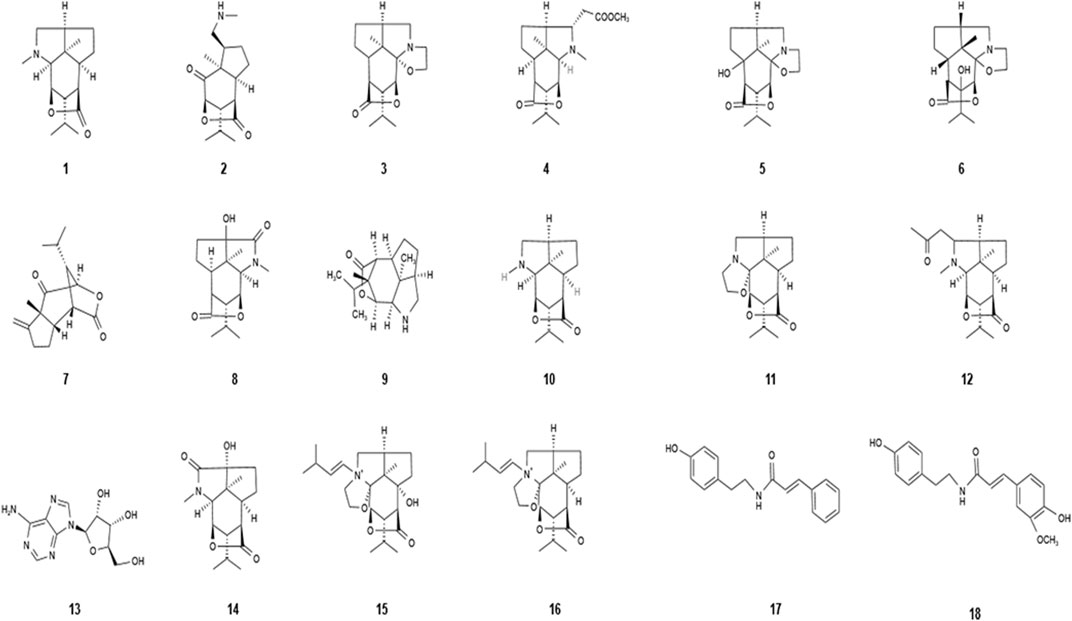
FIGURE 1. Diagram of the chemical structure of alkaloids isolated from Dendrobium nobile Lindl. Different numbers represent the different compounds: 1, dendrobine; 2, nobilonine; 3, dendroxine; 4, dendrine; 5, 6-hydroxydendroxine; 6, 8-hydroxydendroxine; 7, nobilomethylene; 8, 3-hydroxy-2-oxodendrobine; 9, nordendrobine; 10, mubironine B; 11, dendroxine; 12, dendronobiline A; 13, adenosine; 14, 9-hydroxy-10-oxodendrobine; 15, N-isopentenyl-6-hydroxydendroxinium; 16, N-isopentenyldendro xinuum; 17, N-trans-cinnamoyltyramine; and 18, N-trans-feruloyltyramine.
2.2 Polysaccharides
Polysaccharides are biopolymers composed of more than 10 kinds of monosaccharides and are one of the active ingredients in traditional Chinese medicines (TCMs) (Chen et al., 2016). Polysaccharides of Dendrobium nobile Lindl. are one of the main active pharmacological ingredients of Dendrobium nobile Lindl. The polysaccharides are mainly obtained by extracting and isolating four parts of Dendrobium nobile Lindl.: stems, leaves, flowers, and roots, which have a positive effect on anti-tumor, promotion of immune response, anti-oxidation, and anti-inflammation. The different chemical structures of polysaccharides are of great significance for their pharmacological activity. The polysaccharides of Dendrobium nobile Lindl. are often composed of several components with different molecular weight ranges and different monosaccharides with different molecular weights. The polysaccharides of Dendrobium nobile Lindl. consist mainly of mannose, glucose, and galactose, with rhamnose, rham arabinose, and xylose in small amounts (Jiang and Luo, 2011). Several types of polysaccharides have been identified in Dendrobium nobile Lindl. (Wang et al., 2017; Zhang et al., 2016b; Pan et al., 2014). The names and molecular formula of the polysaccharides isolated from Dendrobium nobile Lindl. are listed in Table 3, and their chemical structures are shown in Figure 2. Polysaccharides with different compositions are composed of different monosaccharides and have different biological activities. The polysaccharide content of Dendrobium nobile Lindl. also varies depending on the site and growth period. Zhang et al. (2013) found that the polysaccharide content of Dendrobium nobile Lindl. varies depending on the site, habitat, and growth period. Based on the polysaccharide content in different organs, the polysaccharide content of the two dendrobium species showed a trend of stem > leaf > flower > root, with a significant difference between them. Similarly, in one study, the accumulation of water-soluble polysaccharides in Dendrobium nobile Lindl. first increased with prolonged growth period and then decreased and saturated in the first year, reaching the highest value of 2.83% in the second year, and the water-soluble polysaccharide content decreased to 2.25% in the third year (Yang et al., 2010).
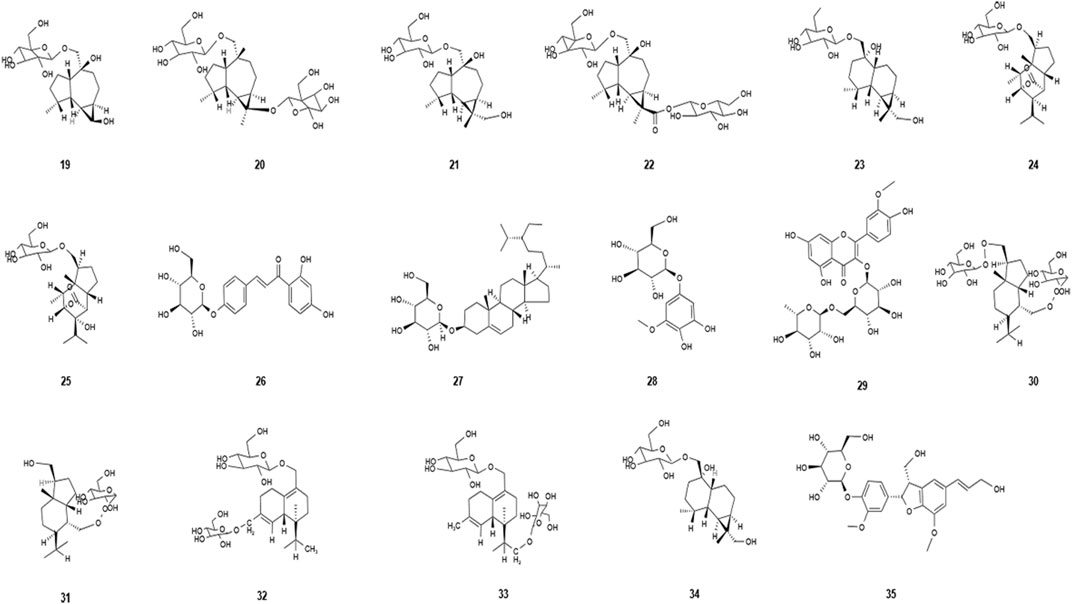
FIGURE 2. Diagram of the chemical structure of polysaccharides isolated from Dendrobium nobile Lindl. Different numbers represent the different compounds: 19, dendroside A; 20, dendroside B; 21, dendroside C; 22, dendroside D; 23, dendroside E; 24, dendroside F; 25, dendroside G; 26, isoliquiritin; 27, daucosterol; 28, koaburaside; 29, isorhamnetin-3-O-β-D-rutinoside; 30, dendronobiloside A; 31, dendronobiloside B; 32, dendronobiloside C; 33, dendronobiloside D; 34, dendronobiloside E; and 35, dehydrodiconiferyl-alcohol-4-β-D-glucoside.
2.3 Bibenzyls
Bibenzyls are a class of compounds consisting of two benzyl units attached to a methyl group by a single C–C bond. They are found in a variety of plants, including mosses, ferns, and angiosperms. Dendrobium, a type of orchid, is a common medicinal plant for bibenzylate extraction. It is also a type of active compound that is abundantly contained in dendrobium, an herbal medicine. Bibenzyls are mainly extracted from the stems of Dendrobium nobile Lindl. (Xiao et al., 2016). It has attracted much attention in recent years due to its excellent anti-tumor activity (Kou et al., 2013). Luo et al. (2006) isolated 31 monomeric compounds from Dendrobium nobile Lindl. by the thiazolyl blue method. The results showed that three benzenes, namely, crepidatin, chrysotobibenzyl, and moscatilin, exhibit a certain growth inhibitory effect against highly invasive human hepatocellular carcinoma cell lines. With the development of extraction technology, researchers have continuously discovered new bibenzyls from Dendrobium nobile Lindl. (Chao et al., 2018). The basic information of bibenzyls from Dendrobium nobile Lindl. has been shown in Table 4 and Figure 3. The bibenzyls also have good anti-oxidant activity. Zhang et al. (2008b) isolated and identified the chemical components in a 60% ethanol aqueous extract of Dendrobium nobile Lindl. and obtained three new bibenzyl compounds, namely, nobilin A, nobilin B, and nobilin C. The activity of these compounds was confirmed in vitro by 1, 1-diphenyl-2-picrylhydrazyl (DPPH) radical scavenging and oxygen-free radical scavenging methods.
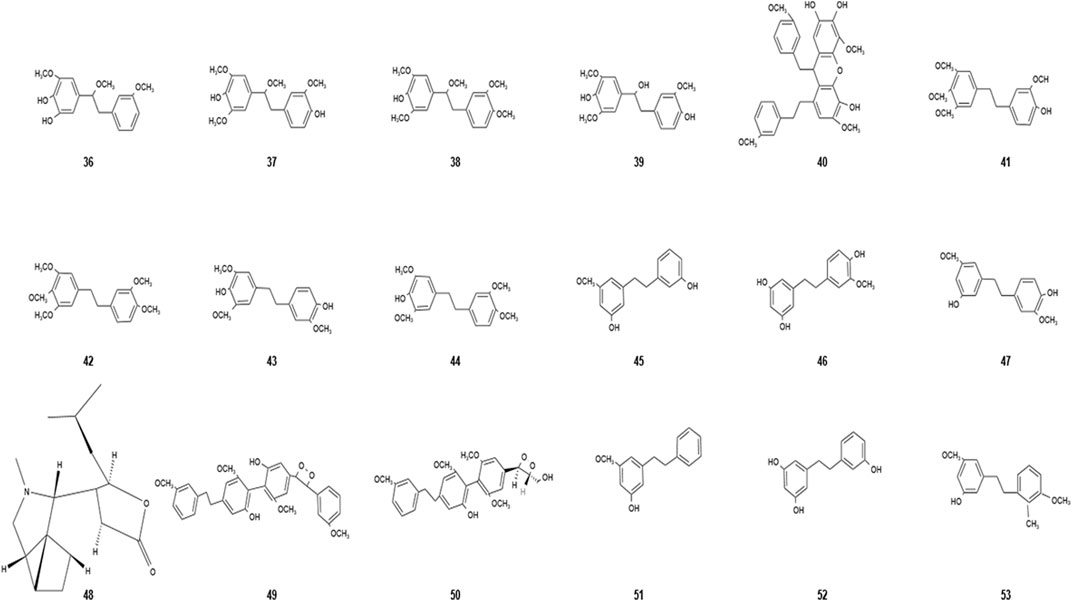
FIGURE 3. Diagram of the chemical structure of bibenzyls isolated from Dendrobium nobile Lindl. Different numbers represent the different compounds: 36, nobilin A; 37, nobilin B; 38, nobilin C; 39, nobilin D; 40, nobilin E; 41, crepidatin; 42, chrysotobibenzyl; 43, moscatilin; 44. chrysotoxine; 45, batatasin III; 46, tristin; 47, gigantol; 48, (-)-dendrobin; 49, dendronophenol A; 50, dendronophenol B; 51, 3-hydroxy-5-methoxybibenzyl; 52, 3,3′,5-trihydroxybibenzyl; and 53, 3-O-methylgigantol.
2.4 Phenanthrenes
Phenanthrene has a wide range of biological activities, but has only been reported in a few families in the plant kingdom, and orchids are the most crucial source of natural phenanthrene (Ling et al., 2021). Phenanthrene is a polycyclic aromatic hydrocarbon composed of three benzene rings. Dendrobium nobile Lindl. is a plant of the orchid family, and phenanthrene is one of the main components of Dendrobium nobile Lindl. and is a substance that has been the subject of much research attention. Subsequently, phenanthrene compounds were continuously extracted and separated from the Dendrobium nobile Lindl. (Zhang et al., 2019; Li et al., 2023). The phenanthrene compounds isolated from Dendrobium nobile Lindl. are listed in Table 5, and their chemical structure information are shown in Figure 4. Phenanthrene compounds are important compounds for studying the anti-tumor effects of Dendrobium nobile Lindl., and several phenanthrene compounds have been found to possess varying degrees of anti-tumor activity. Phenanthrenes are mainly extracted from the dried stems of Dendrobium nobile Lindl. (Ling et al., 2021; Zhou et al., 2018b). Zhou et al. (2018b) extracted, isolated, and purified the natural products from the extract of Dendrobium nobile Lindl. with different chromatographic techniques to isolate four phenanthrene compounds, namely, densiflorolB, cypripedin, moscatin, and 2meme 4-trimethoxy-phenanthrene-3-diol, and were investigated in human breast cancer MCF-7 cells. The results showed that the phenanthrene compounds had a significant inhibitory effect on breast cancer cells, providing a strong basis for anti-tumor studies of phenanthrene compounds in Dendrobium nobile Lindl.
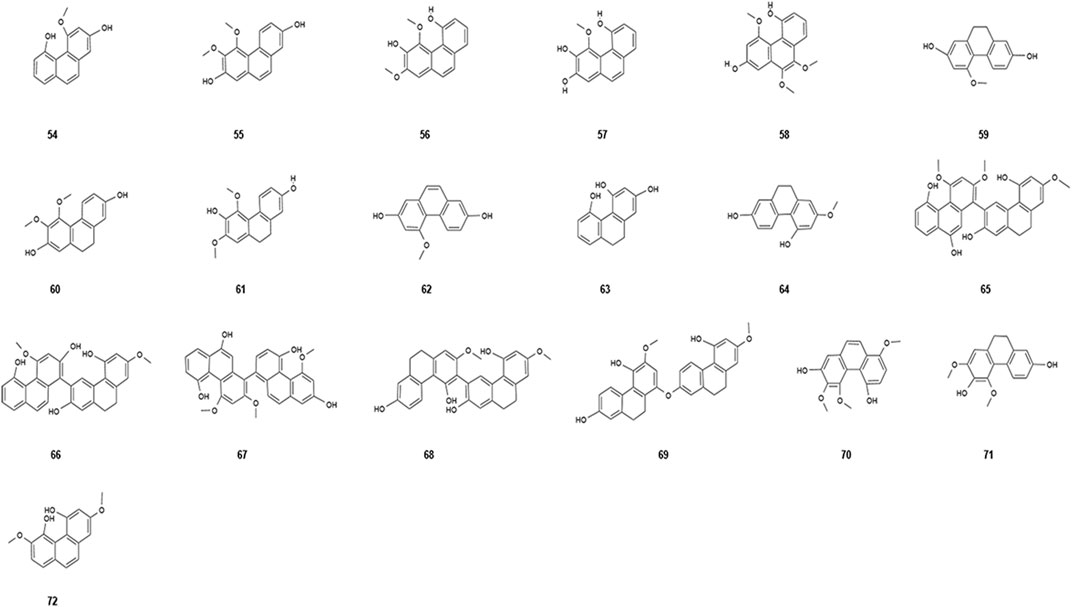
FIGURE 4. Diagram of the chemical structure of phenanthrenes isolated from Dendrobium nobile Lindl. Different numbers represent the different compounds: 54, moscatin; 55, nudol; 56, bulbophyllanthrin; 57, fimbriol B; 58, plicatol A; 59, coelonin; 60, erianthridin; 61, flavanthridin; 62, flavanthrinin; 63, hircinol; 64, lusianthrin; 65, denthyrsinol A; 66, denthyrsinol B; 67, denthyrsinol C; 68, phochinenin G; 69, phochinenin D; 70, 3,4,8-trimethoxyphenanthrene-2,5-diol; 71, 5,7-dimethoxyphenanthrene-2,6-diol; and 72, cannithrene-2.
2.5 Sesquiterpenes
Dendrobium nobile Lindl. contains numerous sesquiterpenes, including picrotoxane, isovanillin, cyclocopacamphane and copacamphane, and juniperane sesquiterpenes. In addition, 10 sesquiterpenes have also been extracted and discovered (Wang P. et al., 2019), which has promoted the investigation and application of sesquiterpenes. In the literature, sesquiterpenes in Dendrobium nobile Lindl. have been found to have neuroprotective, immunomodulatory, diabetic, anti-tumor, and ameliorating effects on acute cerebral ischemia. Zhang et al. (2007) isolated eight sesquiterpenoids from ethanol–water extract of its dried stems and identified one of them as a new compound, dendronobilin J. The compound dendrodensiflorol was isolated from Dendrobium nobile for the first time, and the compound bullatantirol was isolated from Dendrobium for the first time. Based on the remarkable biological activity of sesquiterpenes, the sesquiterpenes of Dendrobium nobile Lindl. have attracted attention of scholars. The detailed information of sesquiterpene compounds has been shown in Table 6 and Figure 5.
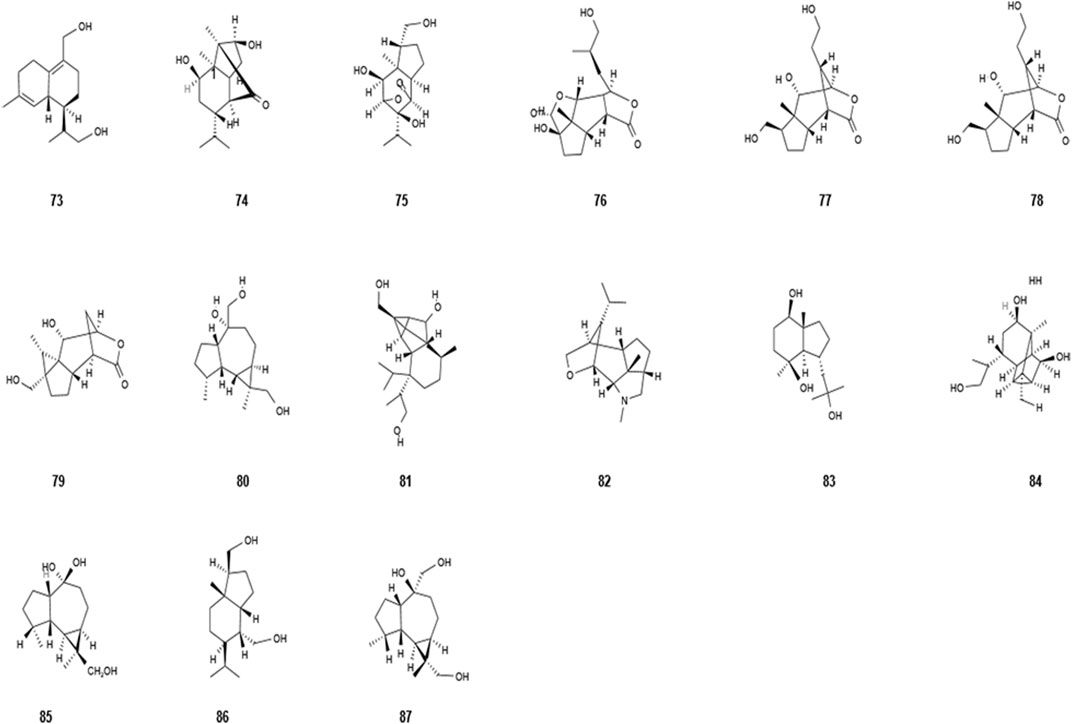
FIGURE 5. Diagram of the chemical structure of sesquiterpenes isolated from Dendrobium nobile Lindl. Different numbers represent the different compounds: 73, δ-cadinen-12,14-diol; 74, dendronobilin A; 75, dendronobilin B; 76, dendronobilin C; 77, dendronobilin D; 78, dendronobilin E; 79, dendronobilin F; 80, dendronobilin H; 81, dendronobilin I; 82, dendrobane A; 83, bullatantirol; 84, dendrobiumane A; 85, 6α,10,12-trihydroxypicrotoxane; 86, 10,12-dihydroxypicmtoxane; and 87, 10β,13,14-trihydroxyalloaromadendrane.
2.6 Tannins
Modern pharmacological studies show that tannins have a variety of biological activities, such as bacteriostasis, anti-virus, anti-oxidation, anti-tumor, and inhibition of gastrointestinal motility, and are widely used in the fields of food and medicine. The extractions of tannins are currently obtained by the isolation and purification of Dendrobium nobile Lindl. stems. Chen et al. determined and compared the content of tannin in Dendrobium nobile Lindl., Dendrobium denneanum Kerr, Dendrobium chrysotoxum Lindl., and Dendrobium fimbriatum Hook., and the results showed that Dendrobium nobile Lindl. had the highest content, and the contents of Dendrobium denneanum Kerr and Dendrobium fimbriatum Hook. were similar (Hen et al., 2013). However, there are few studies on the effects of Dendrobium nobile Lindl. tannin compounds on diseases, which need further scientific exploration.
2.7 Other chemical compositions
Through research and chemical extraction by scientific researchers, it was found that Dendrobium nobile Lindl. has other components such as fluorenone, phenolic acid, coumarin, and lignans in addition to the aforementioned chemical composition (Zhou et al., 2018a; Wang, 2021). The detailed information of the other chemical compositions has been shown in Table 7 and Figure 6. Dendrobium nobile Lindl. has high medicinal value as a valuable herbal medicine, and it would be beneficial to better understand, develop, and utilize Dendrobium nobile Lindl. by extracting the different chemical constituents.

FIGURE 6. Diagram of the chemical structure of other chemical compositions isolated from Dendrobium nobile Lindl. Different numbers represent the different compounds: 88, syringaresinol; 89, pinoresinol; 90, syringic acid; 91, vanillin; 92, apocynin; 93, coniferyl aldehyde; 94, syringaldehyde; 95, p-hydroxybenzaldehyde; 96, p-hydroxybenzoic acid; 97, (+)-denobilone A; 98, (-)-denobilone A; 99, 4-(3-hydroxyphenyl)-2-butanone; and 100, deeumbic acid A.
In summary, the study of the chemical composition of Dendrobium nobile Lindl. focused mainly on alkaloids and polysaccharide compounds because of the realistically high alkaloid and polysaccharide content of Dendrobium nobile Lindl. and because the study was conducted earlier. Then, they were studied from many aspects, including their corresponding pharmacological activity and the effects of different cultivation conditions and different plant parts on their content. At present time, most of the chemical active ingredients found in Dendrobium nobile Lindl. are extracted from the stem part of Dendrobium nobile Lindl., such as alkaloids, polysaccharides, bibenzylates, and phenanthrenes. In addition to the stem, alkaloids and polysaccharides can also be extracted from the leaves of Dendrobium nobile Lindl., and polysaccharide compounds can also be extracted from the flowers and roots of Dendrobium nobile Lindl. With the development of new extraction techniques and detailed studies of the pharmacological activity of Dendrobium nobile Lindl., the discovery of bibenzyls, phenanthrenes, sesquiterpenes, and coumarins gradually attracted people’s attention and became a new direction for the pharmacological activity research of Dendrobium nobile Lindl. For example, studies have shown that bibenzyls and phenanthrenes have certain inhibitory effects on certain types of tumor cells. At present, however, studies on the chemical constituents of Dendrobium nobile Lindl. are mainly alkaloids and polysaccharides, with few reports on other chemical constituents.
3 Experimental research progress of Dendrobium nobile Lindl. in diseases
Dendrobium nobile Lindl., a well-known herbal medicine, has become a research hotspot due to its abundant pharmacological activity and high medicinal value. This has led researchers to conduct many experimental studies on the therapeutic mechanisms of Dendrobium nobile Lindl. in various diseases in order to better understand its pharmacological actions and therapeutic mechanisms. Currently, experimental research on Dendrobium nobile Lindl. is focused primarily on the oncologic, nervous system, cardiovascular, ophthalmic, and gastrointestinal diseases.
3.1 Dendrobium nobile Lindl. and tumor diseases
Many studies have demonstrated that Dendrobium nobile Lindl. has a marked inhibitory effect on a variety of tumor cells (Zhang et al., 2021). In the conventional view, phenanthrenes and bibenzyls were considered to be the major anti-tumor compounds of Dendrobium nobile Lindl. Three bibenzyl components of Dendrobium nobile Lindl.: crepidatin, chrysotobibenzyl, and moscatilin showed different growth inhibitory effects against human hepatocellular carcinoma cell line FHCC-98, and among them, the effect of moscatilin was particularly evident (Luo et al., 2006). Three phenanthrene compounds isolated from Dendrobium nobile Lindl. were also found to significantly inhibit the growth of human breast cancer MCF-7 cells (Zhou et al., 2018b). Nudol, a phenanthrene compound derived from Dendrobium nobile Lindl., was reported to arrest the U2OS cell cycle in the G2/M phase and induce apoptosis in a caspase-dependent manner. In addition, treatment with Nudol inhibited U2OS cell migration (Zhang et al., 2019). With a deeper understanding of the active components of Dendrobium nobile Lindl., other components of Dendrobium nobile Lindl., such as polysaccharides and alkaloids, have also been found to have anti-tumor effects. Polysaccharides of Dendrobium nobile Lindl. have been reported to suppress the BCR-ABL fusion gene mRNA expression in K562 cells, directly inhibit proliferation, and induce apoptosis of chronic myeloid leukemia K562 cells (Zheng, 2010). Ge et al. (2015) found that polysaccharides of Dendrobium nobile Lindl. have a killing effect on leukemia cells and elucidated the mechanism of this effect. He et al. (2017) also observed the effects of a fat-soluble alkaloid extract of Dendrobium nobile Lindl. on HT-29 colon cancer cells by in vitro cell experiments and found that the fat-soluble alkaloid extract of Dendrobium nobile Lindl. reduced the survival rate of HT-29 colon cancer cells and 29 cells, induces apoptosis of HT-29 cells, and inhibits the G2 phase of the cell cycle, thereby inhibiting colon cancer cell growth. The mechanism may be due to the liposoluble alkaloid extract of Dendrobium nobile Lindl. decreasing mitochondrial membrane potential, increasing intracellular reactive oxygen species concentration, and increasing the expression of activated caspases 9 and 3 and intracellular cytochrome.
3.2 Dendrobium nobile Lindl. and nervous system diseases
Recent studies have confirmed that alkaloids, one of the active components of Dendrobium nobile Lindl., have a significant protective effect on the nervous system and play a certain role in treatment. Studies have shown that Dendrobium nobile Lindl. alkaloid (DNLA), the active ingredient of the Chinese herb Dendrobium, reduces the cytotoxicity of amyloid-β protein fragments 25–35 (Aβ25–35) on primary cultured rat neurons and protect against synaptic integrity in cultured neurons by DNLA. The mechanism may be mediated, at least in part, through upregulation of the neurogenesis-related proteins synaptophysin and postsynaptic density-95 (Zhang et al., 2017). Li et al. (2017) found that as a pathological signal of early Alzheimer’s disease, total alkaloids of Dendrobium nobile Lindl. increase autophagic flow by promoting the formation and degradation of autophagosomes in the hippocampus, thereby increasing Aβ25-35 induced axonal degeneration and preventing the development of Alzheimer’s disease (AD). Another study on the effect of DNLA on a rat model of Aβ25-35-induced dementia and its mechanism found that dendrobium alkaloids can improve the content of β-amyloid (Aβ1-42), amyloid precursor protein (APP), and β-site APP cleaving enzyme (BACEI) proteins in the hippocampus, providing a valid basis for the use of DNLA in AD treatment (Zhang et al., 2016a). In addition to improving AD, Dendrobium nobile Lindl. also has the ability to improve memory. For example, the Dendrobium nobile Lindl. alkaloid significantly ameliorates damage and loss of hippocampal neurons by streptozotocin in rats, while simultaneously activating glycogen-synthase kinase-3β (GSK-3b) and inhibiting tau hyperphosphorylation (Ba et al., 2017). Wang et al. (2016a) found that Dendrobium nobile Lindl. polysaccharide attenuated lipopolysaccharide-induced learning memory impairment and neuronal damage in rats. They found that Dendrobium nobile Lindl. polysaccharide could attenuate learning memory impairment and neuronal damage caused by lipopolysaccharides in rats and inhibit inflammation of the hippocampus. The mechanism was to improve learning and memory and to reduce gene and protein expression of tumor necrosis factor-α (TNF-α), interleukin-1β (IL-1β), and transforming growth factor-β1 (TGF-β1) in anti-lipopolysaccharide-induced rat hippocampal neurons. In addition to the prevention of AD and improving memory function, several components of Dendrobium nobile Lindl. can protect neurons and nerve cells. Among them, the polysaccharides of Dendrobium nobile Lindl. protect neurons by inhibiting the activation of lipopolysaccharides in microglia and astrocytes and reducing the production of inflammatory cytokines (Lin et al., 2016). Thus, Dendrobium nobile Lindl. has a great potential for the treatment and protection of nervous system diseases.
3.3 Dendrobium nobile Lindl. and cardiovascular diseases
Hyperlipidemia causes not only vascular damage and atherosclerosis-related complications due to atherosclerosis but also forms atherosclerotic plaques in large and medium arteries, which develop and damage the vessel wall, causing numerous dangerous lesions in the vessel wall that are a major cause of cardiovascular disease. Hyperglycemia can affect blood vessels and predispose to cardiovascular disease and myocardial infarction; Dendrobium nobile Lindl. has favorable hypoglycemic and lipid-lowering effects and is expected to contribute to the prevention and treatment of cardiovascular disease. Polysaccharides of Dendrobium nobile Lindl. have been reported to reduce total cholesterol (TC), triacylglycerol (TG), and low-density lipoprotein cholesterol (LDL-C) in the serum of hyperlipemic rats. In hyperlipidemic rats, it increases high-density lipoprotein cholesterol (HDL-C), decreases liver index and malondialdehyde (MDA) levels in liver tissue, and increases superoxide dismutase (SOD) activity to reduce hepatic adiposity (Li et al., 2008). In addition, total alkaloids of Dendrobium nobile Lindl. were found to attenuate insulin resistance and contribute to hypoglycemia by modulating IRS-2 mRNA and IGF-1 mRNA levels in hepatocytes (Huang et al., 2014). Furthermore, aqueous extracts of Dendrobium nobile Lindl. have the potential to treat hyperlipidemia by lowering serum triglyceride and low-density lipoprotein cholesterol concentrations, decreasing alanine aminotransferase (ALT) activity, and increasing high-density lipoprotein cholesterol concentrations, and aqueous extracts of Dendrobium nobile Lindl. solution have significant lipid-lowering activity, providing experimental evidence for the prevention and treatment of cardiac diseases (Li et al., 2019).
3.4 Dendrobium nobile Lindl. and ophthalmic diseases
There are a number of herbal medicines developed from Dendrobium nobile Lindl. for the treatment of ophthalmic diseases. A thorough study of the pharmacological effects of Dendrobium nobile Lindl. found that Dendrobium nobile Lindl. has a better therapeutic effect on cataracts based on its anti-oxidant, anti-inflammatory, glucose-lowering, and protective effects on oxidized epithelial cells. Recent studies have shown that alkaloids of Dendrobium nobile Lindl. can affect nitric oxide (NO) and inducible nitric oxide synthase (iNOS) activity and their gene expression in the lens of galactose diabetic cataract rats, effectively suppressing the iNOS gene expression, which is diabetic with a better therapeutic effect on cataracts (Wei and Long, 2008). Another study showed that the total alkaloids and crude polysaccharides of Dendrobium nobile Lindl. have certain anti-cataract effects in vitro, the mechanism is related to their antagonistic effects on oxidative damage in the lens, and the total alkaloids of Dendrobium nobile Lindl. have been demonstrated to have a superior anti-cataract effect than polysaccharides (Long et al., 2008). In addition to cataracts, another high-incidence ophthalmic disease, diabetic retinopathy (DR) also damages the human visual system. Considering the anti-inflammatory, anti-oxidant, hypoglycemic, angiogenesis-inhibiting, and retinal damage caused by hyperglycemia, it is clear that reactive oxygen species and inflammatory substances are major factors in DR. Therefore, the use of active ingredients in dendrobium for the treatment of DR has become a hot topic, but there is little literature on the treatment of DR with Dendrobium nobile Lindl. The role of other forms of dendrobium in the treatment of DR, such as Dendrobium chrysotoxum Lindl. and Dendrobium officinale, have also been studied. Yu et al. (2016) observed the ameliorative effect of an ethanol extract of Dendrobium chrysotoxum Lindl. on mice with diabetic retinopathy and found that Dendrobium chrysotoxum Lindl. induced a significant reduction of hypoxia inducible factor-1α (HIF-1α) and vascular endothelial growth factor (VEGF) and its receptors VEGFRl and VEGFR2 in the retina of DR mice, and that it could reduce the elevated levels of VEGF in the vitreous and serum of DR mice. Furthermore, it suppresses retinal neovascularization in DR. Furthermore, Dendrobium officinale polysaccharide reduced retinal and systemic inflammatory cytokine (IL-6 and TNF-α) levels and inhibited the upregulation of retinal VEGF expression in DR rats (Li et al., 2016).Currently, there is no literature on the prophylactic and therapeutic effects of Dendrobium nobile Lindl. on DR. Thus, Dendrobium nobile Lindl. has a large research space in the prevention and treatment of DR.
3.5 Dendrobium nobile Lindl. and gastrointestinal diseases
A recent study showed that Dendrobium nobile Lindl. was effective in increasing ileogastric levels, decreasing growth inhibitors, increasing the rate of small intestinal acceleration, and improving constipation symptoms in a rat model (Gan et al., 2019). Thus, Dendrobium nobile Lindl. may be of clinical value in the treatment of gastrointestinal disorders. In addition, Dendrobium nobile Lindl. extract could increase stool water content, promote intestinal peristalsis, regulate intestinal lactate, and improve symptoms of constipation in mice through a mouse model (Wang et al., 2021). Furthermore, Dendrobium nobile Lindl. has been reported to promote gastric acid secretion and digestion in humans. Experimentally, Dendrobium nobile Lindl. directly stimulates G cells, which is presumed to increase the concentration of gastrin in the blood, resulting in increased gastrin release, higher serum gastrin concentration, and increased acid secretion in the stomach (Chen et al., 1995).
3.6 Dendrobium nobile Lindl. and other diseases
It has been shown that the immune system is somewhat enhanced by the ingestion of Dendrobium nobile Lindl. In animal studies, Dendrobium nobile Lindl. powders of different particle sizes were found to significantly increase the spleen index of mice, indicating that Dendrobium nobile Lindl. enhances immune function in mice at the organ level. In addition, Dendrobium nobile Lindl. also has a protective role in liver function. The alkaloids of Dendrobium nobile Lindl. have been reported to improve the hepatic lipid profile of mice through two pathways: promoting cholesterol excretion by facilitating the binding of hydrophilic sulfate to bile acids and reducing the cholic acid/chenodeoxycholic acid (CA/CDCA) ratio, which is positively correlated with cholesterol absorption. This is in line with the findings of the study. This reveals a protective role of Dendrobium nobile Lindl. alkaloids in liver lipid homeostasis and possible mechanisms (Huang et al., 2019). Another study showed that the protective effect of Dendrobium nobile Lindl. alkaloids against CCl4-induced liver injury was associated with amelioration of mitochondrial oxidative stress and mitochondrial dysfunction, which was dependent on activation of nuclear factor erythroid 2-related factor 2 (Nrf2) signaling (Zhou et al., 2020). In addition, the researchers also found that Dendrobium nobile Lindl. had good anti-microbial activity. Zhang et al. (2012) compared the anti-microbial activity of Dendrobium nobile Lindl. and Dendrobium ferruginum, and the results showed that both types of Dendrobium polysaccharides had significant anti-microbial activity on Staphylococcus aureus, Escherichia coli, and Pneumococcus, and the anti-microbial activity of Dendrobium nobile Lindl. was more obvious. Another study also found that different Dendrobium nobile Lindl. extracts showed good inhibitory effects against five common drug-resistant bacteria Staphylococcus aureus, methicillin-resistant staphylococcus aureus, Pseudomonas aeruginosa, Escherichia coli, and Klebsiella pneumoniae (Wang et al., 2022). The good anti-microbial activity can not only make Dendrobium nobile Lindl. useful in the treatment of infection diseases but also provide a reference for the research and development of new anti-microbial drugs. The aforementioned experimental studies based on the pharmacological effects of the active ingredient of Dendrobium nobile Lindl., such as glucose lowering, anti-tumor, anti-oxidant, and anti-inflammatory effects, have shown therapeutic effects on cancer, nervous system, cardiovascular system, ophthalmology, and gastrointestinal diseases (Figure 7), providing a theoretical and experimental basis for further clinical treatment and a scientific reference for the better development of Dendrobium nobile Lindl. drugs.
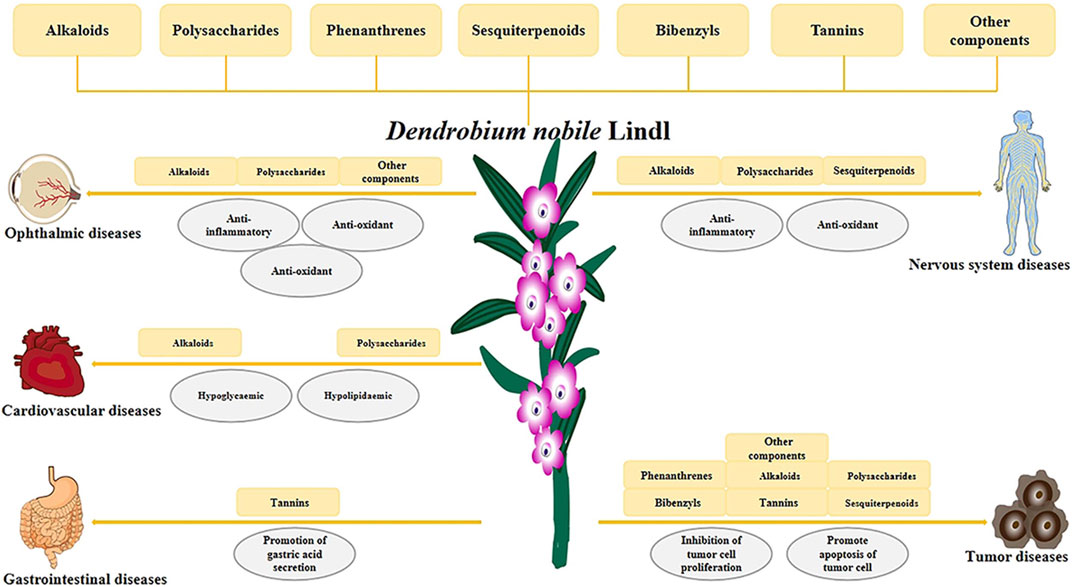
FIGURE 7. Diagram of the application of Dendrobium nobile Lindl. to different diseases. Dendrobium nobile Lindl. is composed of alkaloids, polysaccharides, bibenzyls, phenanthrenes, sesquiterpenoids, tannins, and other chemical components, which have good pharmacological activities, such as anti-inflammatory, anti-oxidant and hypoglycemic, hypolipidaemic, inhibition of tumor cell proliferation, promotion of apoptosis of tumor cell, and promotion of gastric acid secretion. Therefore, according to the aforementioned pharmacological activities, the various chemical components of Dendrobium nobile Lindl. can effectively target different diseases and play a role in clinical therapeutics.
4 Summary
Dendrobium nobile Lindl. is a common herbal medicine and has a long history of medicinal use. This paper outlines the chemical composition of Dendrobium nobile Lindl. and its application in the treatment of clinical diseases. Dendrobium nobile Lindl. is increasingly being applied in the treatment of clinical diseases due to its good pharmacological activity and high medicinal value. The main chemical constituents of Dendrobium nobile Lindl. are alkaloids, polysaccharides, bibenzyls, phenanthrenes, sesquiterpenes, and tannins. Among these, alkaloids and polysaccharides are the typical bioactive components of Dendrobium nobile Lindl. Current research on the chemical composition and pharmacological effects of Dendrobium nobile Lindl. is focused on both alkaloids and polysaccharides. In clinical disease treatment studies, Dendrobium nobile Lindl. has been shown to have pharmacological effects on cardiovascular disease, neurological disease, anti-tumor, cataract treatment, and digestive disease. More notably, Dendrobium nobile Lindl. may play an essential role in the treatment of cardiovascular diseases and diabetes.
At present, there still seems to be some problems in applying the chemical constituents of Dendrobium nobile Lindl. to the treatment of clinical diseases. First, numerous studies have focused on crude extracts of Dendrobium nobile Lindl., but these crude extracts also contain other chemical constituents, leaving the final results observed largely unexplained. Therefore, more detailed studies are needed to elucidate the pharmacological activity and mechanisms of the chemical constituents in Dendrobium nobile Lindl. Second, although the chemical composition and pharmacology of Dendrobium nobile Lindl. have been studied to some extent, its pharmacological activity is mainly focused on the treatment of anti-tumor, hypoglycemia, and nervous system diseases, with little reported on its effects on other diseases. Therefore, in order to discuss the efficacy of Dendrobium nobile Lindl. against various clinical diseases, it would be necessary to consider the mechanism of the combination of multiple chemical components in addition to the therapeutic effect of a single chemical component on a single disease.
Author contributions
HY conceived the idea. CF drafted the manuscript and searched the literature. XS, XW, and HY participated in the manuscript preparation and revised it critically. All authors contributed to the article and approved the submitted version.
Funding
This work was supported by the National Key R&D Program of China (grant number: 2018YFC1004303), the National Natural Science Foundation Project of China (grant number: 82160154), the Key Project of Guizhou Provincial Science and Technology Department (grant number: QKH-JC-2019-1464), the Excellent Talent Support Program of Guizhou Provincial Education Department (grant number: QJH-KY-2017-077), the Science and Technology Foundation of Guizhou Province (grant number: QKH-PTRC-2018-5772-042), the Science and Technology Foundation of Guizhou Provincial Health Commission (grant number: gzwkj2022-268), the Project of Development Research Center of Guizhou Provincial Dendrobium Industry [grant number: QSKH (2019003013)], the Science and Technology Project of Zunyi (grant number: ZSKH-HZ-2020-35), and the Program for Excellent Young Talents of Zunyi Medical University (grant number: 18-ZY-001).
Conflict of interest
The authors declare that the research was conducted in the absence of any commercial or financial relationships that could be construed as a potential conflict of interest.
Publisher’s note
All claims expressed in this article are solely those of the authors and do not necessarily represent those of their affiliated organizations, or those of the publisher, the editors, and the reviewers. Any product that may be evaluated in this article, or claim that may be made by its manufacturer, is not guaranteed or endorsed by the publisher.
References
Ba, Z. S., Cai, R., Yin, C. X., Liu, Y. G., Li, X. H., Gong, Q. H., et al. (2017). Dendrobium nobile Lindl. alkaloids ameliorates streptozotocin - induced hippocampal neuron injury in rats. Chinese Journal of New Drugs and Clinical Remedies 36, 340–346. doi:10.14109/j.cnki.xyylc.2017.06.008
Chao, W. H., Lai, M. Y., Pan, H. T., Shiu, H. W., Chen, M. M., and Chao, H. M. (2018). Dendrobium nobile Lindley and its bibenzyl component moscatilin are able to protect retinal cells from ischemia/hypoxia by dowregulating placental growth factor and upregulating Norrie disease protein. BMC Complement Altern Med 18, 193. doi:10.1186/s12906-018-2256-z
Chen, J., and Shi, J. S. (2016). Research Progress on total alkaloids of Dendrobium nobile. Journal of Modern Medicine & Health 32, 728–730. doi:10.3969/j.issn.1009-5519.2016.05.032
Chen, S. F., Li, Y. Q., Wu, Y. L., Zhou, Z., and Sun, L. H. (1995). Effects of Dendrobium on gastric acid secretion, serum gastrin and plasma somatostatin concentrations. China Journal of Chinese Materia Medica 3, 181–182+193.
Chen, Y., Yao, F., Ming, K., Wang, D., Hu, Y., and Liu, J. (2016). Polysaccharides from Traditional Chinese Medicines: Extraction, Purification, Modification, and Biological Activity. Molecules 12, 1705. doi:10.3390/molecules21121705
Gan, J. H., Huang, Y. F., Peng, D. Y., Yu, N. J., Chen, W. D., Luo, J. P., et al. (2019). Therapeutic effect and mechanism of three kinds of Dendrobium on constipation in rats with spleen Yin deficiency. China Journal of Chinese Materia Medica 44, 2600–2606. doi:10.19540/j.cnki.cjcmm.20190128.002
Ge, X. J., Zheng, L. M., Wang, Y. L., and Tang, Y. P. (2015). Study on effect of dendrobium nobie polysaccharides on expression of WT1 gene in myeloid leukemia cells. Chongqing Medicine 44, 1305–1307. doi:10.3969/j.issn.1671-8348.2015.10.003
He, L., Luo, J., Wang, Y. Y., Shi, Y. J., and Ren, J. W. (2017). Fat-soluble alkaloids extracted from Dendrobium Nobile Lindl induced apoptosis of human colorectal cancer HT-29 cells. Science and Technology of Food Industry 38, 170–174+191. doi:10.13386/j.issn1002-0306.2017.03.024
Heinrich, M., Mah, J., and Amirkia, V. (2021). Alkaloids Used as Medicines: Structural Phytochemistry Meets Biodiversity-An Update and Forward Look. Molecules 26, 1836. doi:10.3390/molecules26071836
Hen, J. J., Guo, L., Xu, L., Wei, L., Luo, F. L., and Zhang, T. M. (2013). Compairison Investigation of the Content of Tannins between Dendrobium aurantiacum and Pharmacopeia Species. Chinese Journal of Experimental Traditional Medical Formulae 19, 61–63. doi:10.13422/j.cnki.syfjx.2013.02.033
Huang, J., Xu, Y. Y., Zhang, M. H., Yang, X. H., Liu, Y., Wu, Q., et al. (2017). The Effects of Dendrobium Nobile Lindl.Alkaloids(DNLA)on α,β and γ-secretase of Hippocampal Neurons in SD Rat. Acta Neuropharmacologica 7, 42. doi:10.3969/j.issn.2095-1396.2017.02.050
Huang, Q., Liao, X., Wu, Q., Gao, L., and Shi, J. S. (2014). Effects of Dendrobium nobile Alkaloids on Blood Glucose and Gene Expression of IRS-2 and IGF-1 in Liver of Rats with Diabetes. Chinese Journal of Experimental Traditional Medical Formulae 20, 155–158. doi:10.13422/j.cnki.syfjx.2014190155
Huang, S., Wu, Q., Liu, H., Ling, H., He, Y., Wang, C., et al. (2019). Alkaloids of dendrobium nobile lindl. Altered hepatic lipid homeostasis via regulation of bile acids. J Ethnopharmacol 241, 111976. doi:10.1016/j.jep.2019.111976
Jiang, Y. L., and Luo, J. P. (2011). Advances on Pharmacological Activities and Chemical Structures of Polysaccharides from Medicinal Dendrobium Species. Lishizhen Medicine and Materia Medica Research 22, 2986–2988. doi:10.3969/j.issn.1008-0805.2011.12.072
Jin, R. L., Sun, J. J., and Zhang, Y. M. (1981). Determination of total alkaloids in 11 species of Dendrobium. Journal of China Pharmaceutical University, 9–13.
Kou, Z. Q., Yan, D. B., and Feng, F. (2013). Advances in studies on the Natural Bibenzyls. Strait Pharmaceutical Journal 25, 1–6. doi:10.3969/j.issn.1006-3765.2013.09.001
Lam, Y., Ng, T. B., Yao, R. M., Shi, J., Xu, K., Sze, S. C., et al. (2015). Evaluation of chemical constituents and important mechanism of pharmacological biology in dendrobium plants. Evid Based Complement Alternat Med 2015, 841752. doi:10.1155/2015/841752
Li, F., Huang, Q., Li, X. Y., Wu, Q., and Shi, J. S. (2008). Effects of the extr acts from Dendrobium nobile lindl on bloodsugar in normal and hyperglycemic mice. Journal of Zunyi Medical University 122, 11–12. doi:10.3969/j.issn.1000-2715.2008.01.005
Li, J. W., Li, G. W., Qun, Y., and Li, C. X. (2016). Effects of polysaccharides of dendrobium candidum on overexpression of inflammatory factors in diabetic rats with retinopathy. China Journal of Chinese Ophthalmology 26, 7–11. doi:10.13444/j.cnki.zgzyykzz.2016.01.003
Li, L. S., Lu, Y. L., Nie, J., Xu, Y. Y., Zhang, W., Yang, W. J., et al. (2017). Dendrobium nobile Lindl alkaloid, a novel autophagy inducer, protects against axonal degeneration induced by Aβ25-35 in hippocampus neurons in vitro. CNS Neurosci Ther 23, 329–340. doi:10.1111/cns.12678
Li, Y., Wang, H. X., Jia, Q. H., He, G. H., and Lyu, W. P. (2019). Effect of Dendrobium Nobile Aqueous Extract on Decreasing Blood Lipid in Rats with Hyperlipidemia. Journal of Food Science and Biotechnology 38, 97–102. doi:10.3969/j.issn
Li, Z., Zeng, M., Geng, K., Lai, D., Xu, Z., and Zhou, W. (2023). Chemical Constituents and Hypoglycemic Mechanisms of Dendrobium nobile in Treatment of Type 2 Diabetic Rats by UPLC-ESI-Q-Orbitrap, Network Pharmacology and In Vivo Experimental Verification. Molecules 28, 2683. doi:10.3390/molecules28062683
Lin, M., Gong, Q. H., Wu, Q., Zhang, F., and Shi, J. S. (2016). Protective effects of NDP on LPS induced neuron injuries in rat mixed cultures. Chinese Pharmacological Bulletin 32, 1144–1148. doi:10.3969/j.issn.1001-1978.2016.08.022
Ling, H. C., Gu, R. H., and Qin, L. K. (2021). Research proress on chemical constituents and pharmacological effects of Dendrobium nobile. Chinese Traditional and Herbal Drugs 52, 7693–7708. doi:10.7501/j.issn.0253-2670.2021.24.032
Long, Y., Wei, X. Y., Zhan, Y. J., Li, X. C., Xu, C. L., and Xu, Q. (2008). In-vitro Experimental Study on the Extract of Dendrobium nobile Lindl. in Counteracting Cataract in Rats. Journal of Guangzhou University of Traditional Chinese Medicine 25, 345–349. doi:10.13359/j.cnki
Lu, A. J., Yu, D. A., He, H. Y., Du, Y. M., Zhang, Q. R., Bai, C. J., et al. (2020). Comparison of dendrobine contents in the Dendrobium nobile population. Journal of Zunyi Medical University 43, 41–46. doi:10.14169/j.cnki.zunyixuebao.2020.0011
Luo, W. J., Wang, G. H., Zhang, X., Chen, Z. N., Wang, N. L., and Yao, X. S. (2006). Inhibitory effect of bibenzyls from Dendrobium Nobile on the proliferation of high invasive hepatoma cell line FHCC-98. Chinese Journal of Tissue Engineering Research 10, 150–152. doi:10.3321/j.issn:1673-8225.2006.43.054
Mou, Z., Zhao, Y., Ye, F., Shi, Y., Kennelly, E. J., Chen, S., et al. (2021). Identification, Biological Activities and Biosynthetic Pathway of Dendrobium Alkaloids. Front Pharmacol 12, 605994. doi:10.3389/fphar.2021.605994
Pan, L. H., Li, X. F., Wang, M. N., Zha, X. Q., Yang, X. F., Liu, Z. J., et al. (2014). Comparison of hypoglycemic and antioxidative effects of polysaccharides from four different Dendrobium species. Int J Biol Macromol 64, 420–7. doi:10.1016/j.ijbiomac.2013.12.024
Shi, B. S., Tao, Y. S., Li, W., Sun, Z. W., Shao, Y. T., Yang, X. L., et al. (2017). Advances in Researches of Chemical Components and Pharmacological Effect from Dendrobium nobile Lindl. Journal of Kunming Medical University 38, 124–129. doi:10.3969/j.issn.1003-4706.2017.10.027
Wang, J., Wang, G. P., Lu, A. J., Qin, L., Lu, Y. L., Bai, C. J., et al. (2022). Evaluation of the antibacterial activity of Dendrobium nobile extracts against resistant organism. 43, 334–338. doi:10.14169/j.cnki.zunyixuebao.2022.0057
Wang, J. H., Zuo, S. R., and Luo, J. P. (2017). Structural Analysis and Immuno-Stimulating Activity of an Acidic Polysaccharide from the Stems of Dendrobium nobile Lindl. Molecules 22, 611. doi:10.3390/molecules22040611
Wang, L. N., Gong, Q. H., Li, F., Wu, Q., and Shi, J. S. (2016a). Dendrobium nobile polysaccharides attenuate learning and memory deficits induced by lipopolysaccharide in rats. Acta Neuropharmacologica 6, 1–8. doi:10.3969/j.issn.2095-1396.2016.01.001
Wang, P., Chen, X., Wang, H., Huang, S., Cai, C., Yuan, J., et al. (2019). Four New Picrotoxane-Type Sesquiterpenes From Dendrobium nobile Lindl. Front Chem 7, 812. doi:10.3389/fchem.2019.00812
Wang, W. W., Fan, H. J., Yang, W. H., Xia, K. Y., Li, H. G., Li, X. L., et al. (2021). Aperient Effect of Dendrobium nobile Lindl Extract on Constipation Model Mice. Science and Technology of Food Industry 42, 342–347. doi:10.13386/j.issn1002-0306.2020120264
Wang, X. Y., Meng, C. W., and Zhou, Q. M. (2019). Research progress of sesquiterpenoids from Dendrobium nobile. Natural Product Research and Development 31, 1837–1845. doi:10.16333/j.1001-6880.2019.10.024
Wang, Y. H. (2021). Traditional Uses and Pharmacologically Active Constituents of Dendrobium Plants for Dermatological Disorders: A Review. Nat Prod Bioprospect 11, 465–487. doi:10.1007/s13659-021-00305-0
Wang, Y. H., Avula, B., Abe, N., Wei, F., Wang, M., Ma, S. C., et al. (2016b). Tandem Mass Spectrometry for Structural Identification of Sesquiterpene Alkaloids from the Stems of Dendrobium nobile Using LC-QToF. Planta Med 82, 662–70. doi:10.1055/s-0042-103031
Wei, X. Y., and Long, Y. (2008). Regulatory effect of Alkaloids extr acted from Dendrobium nobile Lindl on expr ession of iNOS gene in lens of diabetic rats. Anatomy Research 3, 177–180+205. doi:10.3969/j.issn.1671-0770.2008.03.005
Xiao, S. J., Liu, Z. Z., Mao, S., Chen, Y. Z., N, X. Q., Zhang, J. Y., et al. (2016). A new bibenzyl compound from Dendrobium nobi. Acta Pharmaceutica Sinica 51, 1117–1120. doi:10.16438/j.0513-4870.2016-0059
Yan, S., Zhao, T. M., Zhao, X. Q., Xing, J. Y., Hu, Y. D., and Chun, Z. (2018). Comparison of Polysaccharide and Dendrobine Content in Hejiang Dendrobium nobile at Different Har vesting Time. China Pharmacy 29, 73–77. doi:10.6039/j.issn.1001-0408.2018.01.19
Yang, L. C., Xiang, J., Hong, K., Yi, Y., Wang, Y. Z., and Lin, J. Q. (2010). Accumulation of alkaloids and water-soluble polysaccharides in Dendrobium nobile. Lishizhen Medicine and Materia Medica Research 21, 2864–2865. doi:10.3969/j.issn.1008-0805.2010.11.068
Yu, Z. Y., Lu, B., Ji, L. L., and Wang, Z. T. (2016). Ethanol extract of Dendrobium chrysotoxum Lindl on the amelioration of diabetic retinopathy and its engaged mechanism. Journal of International Pharmaceutical Research 43, 301–306. doi:10.13220/j.cnki.jipr.2016.02.019
Zhang, J., Xu, H. X., Zhao, Z. L., Xian, Y. F., and Lin, Z. X. (2021). Dendrobium nobile Lindl: A review on its chemical constituents and pharmacological effects. Chinese Medicine and Culture 4, 235–242. doi:10.4103/CMAC.CMAC_44_21
Zhang, J. H., Cao, J. X., Zhu, G. F., Ye, Q. S., Li, J., and Wang, Z. H. (2013). Polysaccharide and Total Alkaloid Content of Nobile-type Dendrobium. Chinese Journal of Tropical Crops 34, 727–731. doi:10.3969/j.issn.1000-2561.2013.04.026
Zhang, M. H., Li, F., Zhang, W., Wu, Q., and Shi, J. S. (2016a). Effect of Dendrobium nobil Lindl.Alkaloids on the product of Aβ in hippocam pus of rats induced by Aβ25-35. Journal of Zunyi Medical University 39, 18–21. doi:10.14169/j.cnki.zunyixuebao.2016.0005
Zhang, W., Wu, Q., Lu, Y. L., Gong, Q. H., Zhang, F., and Shi, J. S. (2017). Protective effects of Dendrobium nobile Lindl. alkaloids on amyloid beta (25-35)-induced neuronal injury. Neural Regen Res 12, 1131–1136. doi:10.4103/1673-5374.211193
Zhang, X., Gao, H., Han, H. Y., Liu, H. W., Wang, N. L., Yao, X. S., et al. (2007). Influence of polyelectrolyte on the thermosensitive property of PNIPAAm-based copolymer hydrogels. Chinese Traditional and Herbal Drugs 38, 1771–1779. doi:10.1007/s10856-007-3040-7
Zhang, X., Xu, J. K., Wang, N. L., Su, Y. B., Yao, X. S., and Wang, Z. (2008a). Studies on Antioxidant Activity of Bibenzyls and Phenolic Components from Dendrobium nobile. Chinese Pharmaceutical Journal 43, 829–832. doi:10.3321/j.issn:1001-2494.2008.11.008
Zhang, X., Xu, J. K., Wang, Y., Wang, N. L., Li, Y. B., Bei, Z. J., et al. (2008b). Studies on Antioxidant Activity of Bibenzyls and Phenolic Components from Dendrobium nobile. Chinese Pharmaceutical Journal 43, 829–832. doi:10.3321/j.issn:1001-2494.2008.11.008
Zhang, Y., Wang, H., Wang, P., Ma, C., He, G., and Rahman, M. R. (2016b). Optimization of PEG-based extraction of polysaccharides from Dendrobium nobile Lindl. and bioactivity study. Int J Biol Macromol 92, 1057–1066. doi:10.1016/j.ijbiomac.2016.07.034
Zhang, Y., Zhang, Q., Xin, W., Liu, N., and Zhang, H. (2019). Nudol, a phenanthrene derivative from Dendrobium nobile, induces cell cycle arrest and apoptosis and inhibits migration in osteosarcoma cells. Drug Des Devel Ther 13, 2591–2601. doi:10.2147/DDDT.S180610
Zhang, Z. Y., Yang, C. M., Lan, Z., Huang, Q., and Liang, L. Y. (2012). Study on the Value of Polysaccharide in Dendrobium Candidum Antibacterial Action. Guide of China Medicine 10, 439–440. doi:10.15912/j.cnki.gocm.2012.33.050
Zheng, S. Z. (2010). Effects of the proliferation and apoptosis of K562 cell affected by Dendrobium nobile polysaccharides. Zunyi Medical University.
Zhou, J., Zhang, Y., Li, S., Zhou, Q., Lu, Y., Shi, J., et al. (2020). Dendrobium nobile Lindl. alkaloids-mediated protection against CCl4-induced liver mitochondrial oxidative damage is dependent on the activation of Nrf2 signaling pathway. Biomed Pharmacother 129, 110351. doi:10.1016/j.biopha.2020.110351
Zhou, W., Shen, X., C., Zeng, Q., F., Luo, C. R., He, M. Q., and Liang, Y. (2018a). Fluorenone Constituents in Dendrobium nobile. 41, 1887–1889. doi:10.13863/j.issn1001-4454.2018.08.023
Zhou, W., Xia, J., Liang, W. B., Liang, Y., He, X. Y., and Tang, L. (2017). Current research status of chemical constituents and pharmacological effects of Dendrobium nobile. Chinese Journal of NewDrugs 26, 2693–2700.
Keywords: chemical composition, Dendrobium nobile Lindl., application, diseases, treatment
Citation: Fan C, Sun X, Wang X and Yu H (2023) Therapeutic potential of the chemical composition of Dendrobium nobile Lindl.. Front. Pharmacol. 14:1163830. doi: 10.3389/fphar.2023.1163830
Received: 11 February 2023; Accepted: 28 June 2023;
Published: 11 July 2023.
Edited by:
Taravat Ghafourian, Nova Southeastern University, United StatesReviewed by:
Brian A. Wall, The State University of New Jersey, United StatesMd. Ramim Tanver Rahman, Laval University, Canada
Fandong Kong, Chinese Academy of Tropical Agricultural Sciences, China
Copyright © 2023 Fan, Sun, Wang and Yu. This is an open-access article distributed under the terms of the Creative Commons Attribution License (CC BY). The use, distribution or reproduction in other forums is permitted, provided the original author(s) and the copyright owner(s) are credited and that the original publication in this journal is cited, in accordance with accepted academic practice. No use, distribution or reproduction is permitted which does not comply with these terms.
*Correspondence: Hongsong Yu, eXVob25nc29uZ0AxNjMuY29t
 Chenxi Fan
Chenxi Fan Xin Sun
Xin Sun Xin Wang
Xin Wang Hongsong Yu
Hongsong Yu